八腕目:修订间差异
小 机器人(紧急开关):清理CAT:引文格式1维护:未识别语文类型 |
Icosohedral(留言 | 贡献) →习性: 内容扩充,来自英文条目 |
||
| 第29行: | 第29行: | ||
八腕目中的章魚科,是重要的商业性头足类,中国南部沿海的真蛸和北部沿海的短蛸均有一定产量,韓國和日本也把食用章魚當做傳統文化的一部分。蛸的干制品称“八蛸干”或“章鱼干”,除食用外,在中医的理論裡面有补血益气、收敛生肌的作用。 |
八腕目中的章魚科,是重要的商业性头足类,中国南部沿海的真蛸和北部沿海的短蛸均有一定产量,韓國和日本也把食用章魚當做傳統文化的一部分。蛸的干制品称“八蛸干”或“章鱼干”,除食用外,在中医的理論裡面有补血益气、收敛生肌的作用。 |
||
== 演化 == |
== 分类与演化 == |
||
八腕目包含大约300个已知物种,在历史上它被分为两个亚目:[[無翅亞目|无翅亚目]]和[[有翅亞目|有翅亚目]]。<ref>{{Cite book|chapter=|url=https://books.google.com/books?id=swGA8GtK4n8C&pg=PA764|publisher=Marshall Cavendish|date=2004|isbn=978-0-7614-7424-1|language=en|first=Marshall Cavendish|last=Corporation|title=Encyclopedia of the Aquatic World}}</ref> 但最近的研究认为,有翅亚目只是一类更原始的物种,并不是一个独立的[[演化支]]。<ref>{{Cite journal|title=Genus-level phylogeny of cephalopods using molecular markers: current status and problematic areas|url=https://peerj.com/articles/4331|last=Sanchez|first=Gustavo|last2=Setiamarga|first2=Davin H. E.|date=2018-02-12|journal=PeerJ|doi=10.7717/peerj.4331|volume=6|pages=e4331|language=en|issn=2167-8359|pmc=PMC5813590|pmid=29456885|last3=Tuanapaya|first3=Surangkana|last4=Tongtherm|first4=Kittichai|last5=Winkelmann|first5=Inger E.|last6=Schmidbaur|first6=Hannah|last7=Umino|first7=Tetsuya|last8=Albertin|first8=Caroline|last9=Allcock|first9=Louise}}</ref>无翅亚目占了章鱼物种中的大多数,相比有翅亚目,它们缺少两个用于推进游动的{{Le|頭足綱的鰭|Cephalopod fin|鳍}},<ref>{{Cite book|chapter=|url=https://www.worldcat.org/oclc/51445929|publisher=Marshall Cavendish|date=2004|location=New York|isbn=0-7614-7418-8|oclc=51445929|last=Marshall Cavendish Corporation|title=Encyclopedia of the aquatic world.}}</ref> 体内{{Le|鬚蛸殼|Cirrate shell|小壳}}也变为了硬管(Stylet),或者完全消失了。<ref>Fuchs, D.; Ifrim, C.; Stinnesbeck, W. (2008). "A new ''Palaeoctopus'' (Cephalopoda: Coleoidea) from the Late Cretaceous of Vallecillo, north-eastern Mexico, and implications for the evolution of Octopoda". ''Palaeontology''. '''51''' (5): 1129–1139. doi:10.1111/j.1475-4983.2008.00797.x.</ref> |
八腕目包含大约300个已知物种,在历史上它被分为两个亚目:[[無翅亞目|无翅亚目]]和[[有翅亞目|有翅亚目]]。<ref>{{Cite book|chapter=|url=https://books.google.com/books?id=swGA8GtK4n8C&pg=PA764|publisher=Marshall Cavendish|date=2004|isbn=978-0-7614-7424-1|language=en|first=Marshall Cavendish|last=Corporation|title=Encyclopedia of the Aquatic World}}</ref> 但最近的研究认为,有翅亚目只是一类更原始的物种,并不是一个独立的[[演化支]]。<ref>{{Cite journal|title=Genus-level phylogeny of cephalopods using molecular markers: current status and problematic areas|url=https://peerj.com/articles/4331|last=Sanchez|first=Gustavo|last2=Setiamarga|first2=Davin H. E.|date=2018-02-12|journal=PeerJ|doi=10.7717/peerj.4331|volume=6|pages=e4331|language=en|issn=2167-8359|pmc=PMC5813590|pmid=29456885|last3=Tuanapaya|first3=Surangkana|last4=Tongtherm|first4=Kittichai|last5=Winkelmann|first5=Inger E.|last6=Schmidbaur|first6=Hannah|last7=Umino|first7=Tetsuya|last8=Albertin|first8=Caroline|last9=Allcock|first9=Louise}}</ref>无翅亚目占了章鱼物种中的大多数,相比有翅亚目,它们缺少两个用于推进游动的{{Le|頭足綱的鰭|Cephalopod fin|鳍}},<ref>{{Cite book|chapter=|url=https://www.worldcat.org/oclc/51445929|publisher=Marshall Cavendish|date=2004|location=New York|isbn=0-7614-7418-8|oclc=51445929|last=Marshall Cavendish Corporation|title=Encyclopedia of the aquatic world.}}</ref> 体内{{Le|鬚蛸殼|Cirrate shell|小壳}}也变为了硬管(Stylet),或者完全消失了。<ref>Fuchs, D.; Ifrim, C.; Stinnesbeck, W. (2008). "A new ''Palaeoctopus'' (Cephalopoda: Coleoidea) from the Late Cretaceous of Vallecillo, north-eastern Mexico, and implications for the evolution of Octopoda". ''Palaeontology''. '''51''' (5): 1129–1139. doi:10.1111/j.1475-4983.2008.00797.x.</ref> |
||
=== 化 |
=== 演化 === |
||
[[File:Muensterella scutellaris 348.jpg|缩略图|章鱼由侏罗纪时期的 Muensterelloidea 超科演化而来,图为 Muensterelloidea 的化石记录]] |
[[File:Muensterella scutellaris 348.jpg|缩略图|章鱼由侏罗纪时期的 Muensterelloidea 超科演化而来,图为 Muensterelloidea 的化石记录]] |
||
[[头足纲|头足类动物]]从大约5.3亿年前[[寒武纪]]时期的[[单板纲]]演化而来。 |
[[头足纲|头足类动物]]是从大约5.3亿年前[[寒武纪]]时期的[[单板纲]]演化而来的。在大约4.16亿年前的[[泥盆纪]]时期,[[蛸亞綱|蛸亚纲]]从[[鹦鹉螺亚纲]]分离。在大约2.16亿年前的[[二叠纪]]时期,蛸亚纲(包括章鱼和[[開眼亞目|鱿鱼]])的外壳逐渐转移到了身体内部,并由此被分类为[[八腕總目|八腕总目]]和[[十腕總目|十腕总目]]。<ref name=":3">{{Cite journal|title=Cephalopod origin and evolution: A congruent picture emerging from fossils, development and molecules|url=https://doi.org/10.1002/bies.201100001|last=Kröger|first=Björn|last2=Vinther|first2=Jakob|date=2011-06-17|journal=BioEssays|issue=8|doi=10.1002/bies.201100001|volume=33|pages=602–613|issn=0265-9247|last3=Fuchs|first3=Dirk}}</ref>现代章鱼是从[[侏罗纪]]的 Muensterelloidea [[超科]]演化而来的。早期章鱼可能生活在浅海环境,栖息于[[海底生物界]]至[[底层区]]之间。<ref name=":3" /><ref>{{Cite journal|title=First Middle–Late Jurassic gladius vestiges provide new evidence on the detailed origin of incirrate and cirrate octopuses (Coleoidea)|url=https://doi.org/10.1007/s12542-017-0399-8|last=Fuchs|first=Dirk|last2=Schweigert|first2=Günter|date=2018-06-01|journal=PalZ|issue=2|doi=10.1007/s12542-017-0399-8|volume=92|pages=203–217|language=en|issn=1867-6812}}</ref><ref>{{Cite journal|title=The Muensterelloidea: phylogeny and character evolution of Mesozoic stem octopods|url=https://doi.org/10.1002/spp2.1254|last=Fuchs|first=Dirk|last2=Iba|first2=Yasuhiro|date=2019-06-28|journal=Papers in Palaeontology|issue=1|doi=10.1002/spp2.1254|volume=6|pages=31–92|issn=2056-2802|last3=Heyng|first3=Alexander|last4=Iijima|first4=Masaya|last5=Klug|first5=Christian|last6=Larson|first6=Neal L.|last7=Schweigert|first7=Günter}}</ref>章鱼身体的大部分都由软组织构成,所以化石记录比较稀少。作为软体头足类动物,它们缺少亲缘物种(例如[[鹦鹉螺亚纲]]和[[菊石]])的坚硬外壳。<ref>{{Cite web|title=A Broad Brush History of the Cephalopoda - The Cephalopod Page|url=http://www.thecephalopodpage.org/evolution.php|access-date=2022-03-28|work=www.thecephalopodpage.org}}</ref>它们与其它蛸亚纲动物一样有八条肢体,但缺乏被称为[[觸手|触手]](触手的学名为''tentacle,''准确来讲章鱼的触手应当被称为触腕 ''tentacular arm'')的专门用于捕食的肢体,章鱼的肢体更细、更长,仅在其末端附有吸盘。 |
||
=== 系统发生学 === |
|||
以下是根据桑切斯等人于2018年基于[[線粒體|线粒体]]与{{Le|核DNA|Nuclear DNA}}的[[分子系统发生学]]制作的章鱼演化[[分支图]]。<ref>{{Cite journal|title=Genus-level phylogeny of cephalopods using molecular markers: current status and problematic areas|url=https://peerj.com/articles/4331|last=Sanchez|first=Gustavo|last2=Setiamarga|first2=Davin H. E.|date=2018-02-12|journal=PeerJ|doi=10.7717/peerj.4331|volume=6|pages=e4331|language=en|issn=2167-8359|pmc=PMC5813590|pmid=29456885|last3=Tuanapaya|first3=Surangkana|last4=Tongtherm|first4=Kittichai|last5=Winkelmann|first5=Inger E.|last6=Schmidbaur|first6=Hannah|last7=Umino|first7=Tetsuya|last8=Albertin|first8=Caroline|last9=Allcock|first9=Louise}}</ref> 其中[[麝香蛸属]]的位置来自于伊瓦涅斯等人在2020年发表的一篇文章。<ref>{{Cite journal|title=Systematics and Phylogenetic Relationships of New Zealand Benthic Octopuses (Cephalopoda: Octopodoidea)|url=https://www.frontiersin.org/article/10.3389/fmars.2020.00182|last=Ibáñez|first=Christian M.|last2=Fenwick|first2=Mark|date=2020|journal=Frontiers in Marine Science|doi=10.3389/fmars.2020.00182|volume=7|issn=2296-7745|last3=Ritchie|first3=Peter A.|last4=Carrasco|first4=Sergio A.|last5=Pardo-Gandarillas|first5=M. Cecilia}}</ref>年代信息来自于克律格等人在2011年,<ref>{{Cite journal|title=Cephalopod origin and evolution: A congruent picture emerging from fossils, development and molecules|url=https://doi.org/10.1002/bies.201100001|last=Kröger|first=Björn|last2=Vinther|first2=Jakob|date=2011-06-17|journal=BioEssays|issue=8|doi=10.1002/bies.201100001|volume=33|pages=602–613|issn=0265-9247|last3=Fuchs|first3=Dirk}}</ref>以及福克斯等人在2019年的文章。<ref>{{Cite journal|title=The Muensterelloidea: phylogeny and character evolution of Mesozoic stem octopods|url=https://doi.org/10.1002/spp2.1254|last=Fuchs|first=Dirk|last2=Iba|first2=Yasuhiro|date=2019-06-28|journal=Papers in Palaeontology|issue=1|doi=10.1002/spp2.1254|volume=6|pages=31–92|issn=2056-2802|last3=Heyng|first3=Alexander|last4=Iijima|first4=Masaya|last5=Klug|first5=Christian|last6=Larson|first6=Neal L.|last7=Schweigert|first7=Günter}}</ref> |
以下是根据桑切斯等人于2018年基于[[線粒體|线粒体]]与{{Le|核DNA|Nuclear DNA}}的[[分子系统发生学]]制作的章鱼演化[[分支图]]。<ref>{{Cite journal|title=Genus-level phylogeny of cephalopods using molecular markers: current status and problematic areas|url=https://peerj.com/articles/4331|last=Sanchez|first=Gustavo|last2=Setiamarga|first2=Davin H. E.|date=2018-02-12|journal=PeerJ|doi=10.7717/peerj.4331|volume=6|pages=e4331|language=en|issn=2167-8359|pmc=PMC5813590|pmid=29456885|last3=Tuanapaya|first3=Surangkana|last4=Tongtherm|first4=Kittichai|last5=Winkelmann|first5=Inger E.|last6=Schmidbaur|first6=Hannah|last7=Umino|first7=Tetsuya|last8=Albertin|first8=Caroline|last9=Allcock|first9=Louise}}</ref> 其中[[麝香蛸属]]的位置来自于伊瓦涅斯等人在2020年发表的一篇文章。<ref>{{Cite journal|title=Systematics and Phylogenetic Relationships of New Zealand Benthic Octopuses (Cephalopoda: Octopodoidea)|url=https://www.frontiersin.org/article/10.3389/fmars.2020.00182|last=Ibáñez|first=Christian M.|last2=Fenwick|first2=Mark|date=2020|journal=Frontiers in Marine Science|doi=10.3389/fmars.2020.00182|volume=7|issn=2296-7745|last3=Ritchie|first3=Peter A.|last4=Carrasco|first4=Sergio A.|last5=Pardo-Gandarillas|first5=M. Cecilia}}</ref>年代信息来自于克律格等人在2011年,<ref>{{Cite journal|title=Cephalopod origin and evolution: A congruent picture emerging from fossils, development and molecules|url=https://doi.org/10.1002/bies.201100001|last=Kröger|first=Björn|last2=Vinther|first2=Jakob|date=2011-06-17|journal=BioEssays|issue=8|doi=10.1002/bies.201100001|volume=33|pages=602–613|issn=0265-9247|last3=Fuchs|first3=Dirk}}</ref>以及福克斯等人在2019年的文章。<ref>{{Cite journal|title=The Muensterelloidea: phylogeny and character evolution of Mesozoic stem octopods|url=https://doi.org/10.1002/spp2.1254|last=Fuchs|first=Dirk|last2=Iba|first2=Yasuhiro|date=2019-06-28|journal=Papers in Palaeontology|issue=1|doi=10.1002/spp2.1254|volume=6|pages=31–92|issn=2056-2802|last3=Heyng|first3=Alexander|last4=Iijima|first4=Masaya|last5=Klug|first5=Christian|last6=Larson|first6=Neal L.|last7=Schweigert|first7=Günter}}</ref> |
||
| 第58行: | 第59行: | ||
}} |
}} |
||
根据对章鱼的分子分析表明,[[有翅亞目|有翅亚目]]和[[船蛸總科|船蛸总科]]不是合理的分类,已被分 |
根据对章鱼的[[分子遺傳學|遗传分析]]表明,[[有翅亞目|有翅亚目]]和[[船蛸總科|船蛸总科]]不是合理的分类,其中所包含的物种已被重新归类到分支图各处,这些名称在下面的分支图上以引号和斜体显示。 |
||
{{clade |
{{clade |
||
| 第116行: | 第117行: | ||
}} |
}} |
||
== |
== 特征 == |
||
[[File:Schematic lateral aspect of octopod features.jpg|左|缩略图|350x350像素|章鱼外表图示,从左到右分别为:鳃(outer gill lamellae)、壳口(aperture)、虹吸管(funnel)、眼(eye)、假眼(ocellus),网状构造(web)、触手(arm)、上侧触手(dorsal)、suckers(吸盘)、化茎腕(hectocotylus)、化茎腕尖(ligula)]] |
[[File:Schematic lateral aspect of octopod features.jpg|左|缩略图|350x350像素|章鱼外表图示,从左到右分别为:鳃(outer gill lamellae)、壳口(aperture)、虹吸管(funnel)、眼(eye)、假眼(ocellus),网状构造(web)、触手(arm)、上侧触手(dorsal)、suckers(吸盘)、化茎腕(hectocotylus)、化茎腕尖(ligula)]] |
||
章魚的身體呈現鵝蛋形或圆形,肌肉强健,外套腔开口窄,体表一般不具水孔。 |
章魚的身體呈現鵝蛋形或圆形,肌肉强健,外套腔开口窄,体表一般不具水孔。 |
||
| 第137行: | 第138行: | ||
章鱼的眼睛位于头部上侧,在结构上与[[鱼]]的眼睛类似,它被包裹在与颅骨融合的[[软骨]]囊中。章鱼的[[角膜|眼角膜]]是半透明的表皮层,[[瞳孔]]呈狭缝状,像是在角膜后面[[虹膜]]上的一个洞。[[晶状体]]悬浮在瞳孔后面,最里面是感光的[[视网膜]]细胞,它们覆盖了整个眼睛的内侧。瞳孔的大小可以调整,在明亮条件下,视网膜色素会屏蔽部分光线。<ref>{{Cite book|edition=Seventh edition|chapter=|url=https://www.worldcat.org/oclc/970002268|date=2004|location=Delhi, India|isbn=978-81-315-0104-7|oclc=970002268|first=Robert D.|last=Barnes|first2=Richard S.|last2=Fox|title=Invertebrate zoology : a functional evolutionary approach}}</ref> |
章鱼的眼睛位于头部上侧,在结构上与[[鱼]]的眼睛类似,它被包裹在与颅骨融合的[[软骨]]囊中。章鱼的[[角膜|眼角膜]]是半透明的表皮层,[[瞳孔]]呈狭缝状,像是在角膜后面[[虹膜]]上的一个洞。[[晶状体]]悬浮在瞳孔后面,最里面是感光的[[视网膜]]细胞,它们覆盖了整个眼睛的内侧。瞳孔的大小可以调整,在明亮条件下,视网膜色素会屏蔽部分光线。<ref>{{Cite book|edition=Seventh edition|chapter=|url=https://www.worldcat.org/oclc/970002268|date=2004|location=Delhi, India|isbn=978-81-315-0104-7|oclc=970002268|first=Robert D.|last=Barnes|first2=Richard S.|last2=Fox|title=Invertebrate zoology : a functional evolutionary approach}}</ref> |
||
[[File:Dumbo-hires (cropped).jpg|缩略图|一只属于[[有翅亞目|有翅亚目]]下的[[烟灰蛸]],它有着与多数章鱼不同的身体形态]] |
[[File:Dumbo-hires (cropped).jpg|缩略图|一只属于[[有翅亞目|有翅亚目]]下的[[烟灰蛸]],它有着与多数章鱼不同的身体形态]] |
||
部分章鱼品种有独特的形态。例如[[有翅亞目|有翅亚目]]有肥硕的躯体,触手基部有网状结构,眼睛上方有两个巨大的由{{Le|内壳|Cirrate shell}}支撑的{{Le|頭足綱的鰭|Cephalopod fin|鳍}},它的触手吸盘上有类似纤毛(cirri)的肉状结构,眼睛也更加发达。<ref>{{Cite web|title=Finned Deep-sea Octopuses ~ MarineBio Conservation Society|url=https://www.marinebio.org/species/finned-deep-sea-octopuses/grimpoteuthis-spp/|access-date=2022-03-25|date=2017-05-18|language=en-US}}</ref><ref>{{Cite book|chapter=|url=https://www.worldcat.org/oclc/51445929|publisher=Marshall Cavendish|date=2004|location=New York|isbn=0-7614-7418-8|oclc=51445929|last=Marshall Cavendish Corporation|title=Encyclopedia of the aquatic world.}}</ref> |
部分章鱼品种有独特的形态。例如[[有翅亞目|有翅亚目]]有肥硕的躯体,触手基部有网状结构,眼睛上方有两个巨大的由{{Le|内壳|Cirrate shell}}支撑的{{Le|頭足綱的鰭|Cephalopod fin|鳍}},它的触手吸盘上有类似纤毛(cirri)的肉状结构,眼睛也更加发达。<ref name=":4">{{Cite web|title=Finned Deep-sea Octopuses ~ MarineBio Conservation Society|url=https://www.marinebio.org/species/finned-deep-sea-octopuses/grimpoteuthis-spp/|access-date=2022-03-25|date=2017-05-18|language=en-US}}</ref><ref>{{Cite book|chapter=|url=https://www.worldcat.org/oclc/51445929|publisher=Marshall Cavendish|date=2004|location=New York|isbn=0-7614-7418-8|oclc=51445929|last=Marshall Cavendish Corporation|title=Encyclopedia of the aquatic world.}}</ref> |
||
=== 血液循环 === |
=== 血液循环 === |
||
| 第167行: | 第168行: | ||
=== 墨囊 === |
=== 墨囊 === |
||
章鱼的{{Le|墨囊|Ink sac}}位于其消化腺下方。墨囊上附有一个腺体,用于分泌{{Le|墨汁(头足类)|Cephalopod ink|墨汁}},墨囊储存这些墨汁。墨囊的位置靠近虹吸管,所以排出墨水的动作可以推动章鱼身体迅速移动。墨水从墨囊到虹吸管的途中会混入一些粘液,于是喷出的墨水会在附近产生一片浓厚的黑色浑浊,帮助章鱼从被捕食的险境逃脱。<ref name=":2" /> 墨水的主要色素成分是[[黑色素]],<ref>{{Cite journal|title=Cephalopod Ink: Production, Chemistry, Functions and Applications|url=https://www.mdpi.com/1660-3397/12/5/2700|last=Derby|first=Charles D.|date=2014-05|journal=Marine Drugs|issue=5|doi=10.3390/md12052700|volume=12|pages=2700–2730|language=en|issn=1660-3397|pmc=PMC4052311|pmid=24824020}}</ref>有翅亚目通常没有墨囊。<ref>{{Cite web|title=Finned Deep-sea Octopuses ~ MarineBio Conservation Society|url=https://www.marinebio.org/species/finned-deep-sea-octopuses/grimpoteuthis-spp/|access-date=2022-03-28|date=2017-05-18|language=en-US}}</ref> |
章鱼的{{Le|墨囊|Ink sac}}位于其消化腺下方。墨囊上附有一个腺体,用于分泌{{Le|墨汁(头足类)|Cephalopod ink|墨汁}},墨囊储存这些墨汁。墨囊的位置靠近虹吸管,所以排出墨水的动作可以推动章鱼身体迅速移动。墨水从墨囊到虹吸管的途中会混入一些粘液,于是喷出的墨水会在附近产生一片浓厚的黑色浑浊,帮助章鱼从被捕食的险境逃脱。<ref name=":2" /> 墨水的主要色素成分是[[黑色素]],<ref>{{Cite journal|title=Cephalopod Ink: Production, Chemistry, Functions and Applications|url=https://www.mdpi.com/1660-3397/12/5/2700|last=Derby|first=Charles D.|date=2014-05|journal=Marine Drugs|issue=5|doi=10.3390/md12052700|volume=12|pages=2700–2730|language=en|issn=1660-3397|pmc=PMC4052311|pmid=24824020}}</ref>有翅亚目通常没有墨囊。<ref>{{Cite web|title=Finned Deep-sea Octopuses ~ MarineBio Conservation Society|url=https://www.marinebio.org/species/finned-deep-sea-octopuses/grimpoteuthis-spp/|access-date=2022-03-28|date=2017-05-18|language=en-US}}</ref> |
||
| ⚫ | 章魚墨汁是粘稠的混懸液,每毫升中含200mg球形顆粒,有些章魚可連續六次往外噴射,儲積“墨汁”需要半個多小時的時間{{sfnp|Mather|Anderson|Wood|2010|p=107}}。墨汁的化学成分为黑色素([[吲哚醌]])和蛋白多糖复合体<ref>{{cite journal|title=Cephalopod Ink: Production, Chemistry, Functions and Applications|author=Derby, C. D.|journal=Marine Drugs|issue=5|doi=10.3390/md12052700|year=2014|volume=12|pages=2700–2730}}</ref>,還有[[瘫痪|麻痹]]敵人的毒素,對人類無害可食用,甚至可以作為寫毛筆字用的墨汁。 |
||
== 分布 == |
== 分布 == |
||
[[File:Octopus cyaneain Kona.jpg|缩略图|生活在夏威夷海底的[[藍章 (章魚科)|蓝章]]]] |
[[File:Octopus cyaneain Kona.jpg|缩略图|生活在夏威夷海底的[[藍章 (章魚科)|蓝章]]]] |
||
章鱼分布于 |
章鱼广泛分布于世界各大洋的热带及温带海域,不同的章鱼品种适应不同的海洋环境。大多数青少年期的章鱼生活在较浅的[[潮池]]。[[藍章 (章魚科)|蓝章]]生活在[[珊瑚礁]]生态系统;[[船蛸]]漂浮于[[遠洋帶|远洋带]];{{Le|刺断腕蛸|Abdopus aculeatus}}生活在靠近海岸的[[海草]]环境中。有些章鱼适应了寒冷、黑暗的深海环境,[[深海多足蛸屬|深海多足蛸]]被发现于海底 1000 米处,{{Le|火神蛸|Vulcanoctopus hydrothermalis}}被发现生活在海底 2000 米处的[[海底熱泉|热泉喷口]]。<ref>{{Cite book|chapter=|url=https://www.worldcat.org/oclc/436623449|publisher=Timber Press|date=2010|location=Portland, Or.|isbn=978-1-60469-067-5|oclc=436623449|first=Roland C.|last=Anderson|first2=James B.|last2=Wood|title=Octopus : the ocean's intelligent invertebrate}}</ref>[[有翅亞目|有翅亚目]]通常生活于深海栖息地。<ref>{{Cite book|chapter=|url=https://books.google.com/books?id=swGA8GtK4n8C&pg=PA764|publisher=Marshall Cavendish|date=2004|isbn=978-0-7614-7424-1|language=en|first=Marshall Cavendish|last=Corporation|title=Encyclopedia of the Aquatic World}}</ref>尽管研究者发现了一些生活于[[半深海带]]和[[深海带]]的章鱼,但至今只有一只生活在[[超深渊带]]的章鱼被记录在案,这只章鱼属于[[烟灰蛸属]],被发现于 6,957 米下的海底。<ref>{{Cite journal|title=First in situ observation of Cephalopoda at hadal depths (Octopoda: Opisthoteuthidae: Grimpoteuthis sp.)|url=https://doi.org/10.1007/s00227-020-03701-1|last=Jamieson|first=Alan J.|last2=Vecchione|first2=Michael|date=2020-05-26|journal=Marine Biology|issue=6|doi=10.1007/s00227-020-03701-1|volume=167|pages=82|language=en|issn=1432-1793}}</ref>目前尚未发现生活在淡水环境中的章鱼品种。<ref>{{Cite web|title=Are there any freshwater cephalopods?|url=https://www.abc.net.au/science/articles/2013/01/16/3670198.htm|access-date=2022-03-24|date=2013-01-16|work=www.abc.net.au|language=en-AU}}</ref> |
||
| ⚫ | |||
== 習性 == |
== 習性 == |
||
| ⚫ | 章魚都有[[變色]]能力,這種變色能力來自章魚體內的[[色素細胞]],當遇到危險及靜止時,有[[偽裝 (動物學)|偽裝]]的作用,藉以逃避敵人及伺機獵食<ref name="Ruppert">{{cite book |title=Invertebrate Zoology |last1=Ruppert |first1=Edward E. |last2=Fox |first2=Richard S. |last3=Barnes |first3=Robert D. |url={{google books |plainurl=y |id=W2v0kQEACAAJ |page=363}}|year=2008 |publisher=Cengage Learning |isbn=978-81-315-0104-7 |pages=363–364 }}</ref><ref>{{Cite journal | last1=Semmens | title=Understanding octopus growth: patterns, variability and physiology | url=https://archive.org/details/sim_marine-and-freshwater-research_2004_55_4/page/367 | date=2004 | doi=10.1071/MF03155 | volume=55 | journal=Marine and Freshwater Research | pages=367}}</ref>。章魚具有發達的[[脑|大腦]]。將食物放在一個有蓋的玻璃瓶子內,實驗人員示範打開瓶蓋,再放入章魚的[[魚缸]],章魚會學習並嘗試打開瓶蓋進食。 |
||
| ⚫ | |||
| ⚫ | 章魚是肉食性的,食物包括[[螃蟹]]、[[魚類]]、[[貝類]]、[[海星]],大型的章魚甚至捕食[[龍蝦]]、大[[鱼|魚]]及中小型的[[鯊魚]]<ref>{{en}}{{cite news |publisher=National Geographic |accessdate=2010年7月9日 |title=章魚吃鯊魚 |url= }}</ref>。章魚的天敵不多,[[鯙科|“韌魚”]]是少數能壓倒性制伏章魚的海洋天敵,牠們能將章魚的觸手逐一咬斷。當章魚遇到天敵時,會噴出墨汁逃走,或者以變色偽裝。章魚的觸手如被折斷,不久後可以重新長回。另外,章魚有喜歡鑽進任何的洞穴內的習性,因此一些漁民(特別是[[日本]]的漁民)會以此特製出沉在海底的陶製{{tsl|ja|蛸壺|蛸壺}},章魚進入蛸壺後便無法逃出來。 |
||
在非交配时期,大多数章鱼都独自活动,<ref>{{Cite web|title=What’s Odd About That Octopus? It’s Mating Beak to Beak.|url=https://www.nationalgeographic.com/magazine/article/basic-instincts-octopus-mating|access-date=2022-03-29|date=2016-04-01|work=Magazine|language=en}}</ref>但也有少数章鱼偏好集体活动,它们会时常聚集在一起,频繁交流,发送信号,保护配偶,或是将某些成员逐出社群。章鱼聚集的原因可能是由于当地食物充足,再加上可选的定居点有限。<ref>{{Cite journal|title=A second site occupied by Octopus tetricus at high densities, with notes on their ecology and behavior|url=https://doi.org/10.1080/10236244.2017.1369851|last=Scheel|first=David|last2=Chancellor|first2=Stephanie|date=2017-07-04|journal=Marine and Freshwater Behaviour and Physiology|issue=4|doi=10.1080/10236244.2017.1369851|volume=50|pages=285–291|issn=1023-6244|last3=Hing|first3=Martin|last4=Lawrence|first4=Matthew|last5=Linquist|first5=Stefan|last6=Godfrey-Smith|first6=Peter}}</ref> 其中,{{Le|太平洋巨型条纹章鱼|Larger Pacific striped octopus}}(LPSO, Larger Pacific Striped Octopus)被认为是最具社会性的章鱼,曾有记录到多达40位成员的 LPSO 社群。<ref>Rodaniche, Arcadio F. (1991). "Notes on the behavior of the Larger Pacific Striped Octopus, an undescribed species of the genus Octopus". ''Bulletin of Marine Science''. '''49''': 667.</ref><ref>{{Cite journal|title=Behavior and Body Patterns of the Larger Pacific Striped Octopus|url=https://journals.plos.org/plosone/article?id=10.1371/journal.pone.0134152|last=Caldwell|first=Roy L.|last2=Ross|first2=Richard|date=2015-08-12|journal=PLOS ONE|issue=8|doi=10.1371/journal.pone.0134152|volume=10|pages=e0134152|language=en|issn=1932-6203|pmc=PMC4534201|pmid=26266543|last3=Rodaniche|first3=Arcadio|last4=Huffard|first4=Christine L.}}</ref> 章鱼倾向选择坚硬的掩藏物作为栖息处,例如岩石的缝隙,有些章鱼品种也会选择在沙子或淤泥中挖洞作为巢穴。章鱼没有[[领域 (动物)|领地]]意识,但它们仍偏向于在栖息处附近活动,它们有时会到远处寻找食物。章鱼可以借助导航能力回到巢穴,而不必依照原路返回。<ref>{{Cite journal|title=Navigation by spatial memory and use of visual landmarks in octopuses|url=https://doi.org/10.1007/BF00199609|last=Mather|first=Jennifer A.|date=1991-04-01|journal=Journal of Comparative Physiology A|issue=4|doi=10.1007/BF00199609|volume=168|pages=491–497|language=en|issn=1432-1351}}</ref>章鱼不是[[動物遷徙|迁徙]]性动物。<ref name=":1" /> |
|||
| ⚫ | |||
章鱼会把捕获的猎物带回巢穴。有时章鱼捕获的猎物超出了自己的食物需求,它会将这些多余的尸体与食物残渣丢在巢穴周围。有时,鱼、螃蟹、软体动物和[[棘皮动物]]会聚集在章鱼巢穴周围,与它一同分享这些食物,这些小动物有些是[[食腐動物|食腐者]],有些则是章鱼捕食过程中的幸存者。<ref name=":5">Carefoot, Thomas. "[https://web.archive.org/web/20170508060739/http://www.asnailsodyssey.com/LEARNABOUT/OCTOPUS/octoFeed.php Octopuses and Relatives: Feeding, diets and growth]". ''A Snail's Odyssey''. Archived from the [http://www.asnailsodyssey.com/LEARNABOUT/OCTOPUS/octoFeed.php original] on 8 May 2017. Retrieved 13 April 2017.</ref>在十分罕见的情况下,章鱼会与其它物种[[互利共生|相互合作]],会将其它鱼类视为自己的搭档。它会通过用触手拍打的方式来调整狩猎目标的群体组成,以及引导合作搭档的行为。<ref>{{Cite journal|title=Octopuses punch fishes during collaborative interspecific hunting events|url=https://doi.org/10.1002/ecy.3266|last=Sampaio|first=Eduardo|last2=Seco|first2=Martim Costa|date=2021-02-02|journal=Ecology|issue=3|doi=10.1002/ecy.3266|volume=102|issn=0012-9658|last3=Rosa|first3=Rui|last4=Gingins|first4=Simon}}</ref> |
|||
章魚具有發達的[[脑|大腦]]。將食物放在一個有蓋的玻璃瓶子內,實驗人員示範打開瓶蓋,再放入章魚的[[魚缸]],章魚會學習並嘗試打開瓶蓋進食。 |
|||
=== 捕食 === |
|||
| ⚫ | |||
几乎所有种类的章鱼都是肉食者。栖息于海底的章鱼主要捕食[[甲殼亞門|甲壳动物]]和[[多毛纲]],并且也捕食其它一些[[软体动物]],例如海螺和蛤蜊。生活在开放海域的章鱼主要捕食对虾、鱼类和其它[[头足纲|头足类]]。<ref name=":6">{{Cite web|title=Feeding and predation|url=https://teara.govt.nz/en/octopus-and-squid/page-3|access-date=2022-03-29|last=Taonga|first=New Zealand Ministry for Culture and Heritage Te Manatu|work=teara.govt.nz|language=en}}</ref> 太平洋巨型章鱼的食谱包括[[双壳纲]]软体动物,例如[[鸟蛤科|鸟尾蛤]]、蛤蜊、扇贝,以及一些甲壳类动物,例如螃蟹和[[蜘蛛蟹總科|蜘蛛蟹]]。章鱼一般不会捕食[[玉螺科|玉螺]],因为它们太大了,章鱼也不会捕食[[歐洲帽貝屬|帽贝]]、{{Le|岩扇贝|Crassadoma}}、[[多板纲]]和[[鮑魚|鲍鱼]],因为它们十分紧密的依附在岩石上,难以采集。<ref name=":5" /> |
|||
底栖(生活在海底)章鱼通常在岩石间活动,并且可以穿过岩石的缝隙。章鱼可以借助喷射冲向猎物,并使用触手上的吸盘固定猎物,将其拉到嘴边。小型猎物可以被触手基部的网状结构完全包裹。针对螃蟹等甲壳类动物,章鱼会向它们注射一种麻痹性的唾液,然后凭借尖利的喙将其肢解。<ref name=":6" /><ref name=":0" />当捕食带壳的软体动物时,章鱼会尝试将它们的外壳掰开,或是在壳上钻一个洞,向里面注入[[神經毒素|神经毒素]]。过去人们曾以为章鱼是使用齿舌在贝壳上钻洞的,但现在已经证明,这个过程用到了章鱼唾腺凸起处的微型牙齿,并且它们的唾液中还会分泌出一种可以分解碳酸钙的酶。普通章鱼大约需要花费三个小时才能在甲壳上钻出一个直径 0.6 毫米的洞。一旦外壳被穿透,甲壳类猎物几乎瞬间死亡,随后其肌肉就会松弛,章鱼能够轻易地移除其中的软组织。针对螃蟹的捕食也是同样的方式:章鱼会尝试穿透硬壳螃蟹的外壳,而软壳的螃蟹则直接被撕碎。<ref>Carefoot, Thomas. "[https://web.archive.org/web/20170606005247/http://www.asnailsodyssey.com/LEARNABOUT/OCTOPUS/octoHand.php Octopuses and Relatives: Prey handling and drilling]". ''A Snail's Odyssey''. Archived from the [http://www.asnailsodyssey.com/LEARNABOUT/OCTOPUS/octoHand.php original] on 6 June 2017. Retrieved 21 April 2017.</ref> |
|||
| ⚫ | 章魚墨汁是粘稠的混懸液,每毫升中含200mg球形顆粒,有些章魚可連續六次往外噴射,儲積“墨汁”需要半個多小時的時間{{sfnp|Mather|Anderson|Wood|2010|p=107}}。墨汁的化学成分为黑色素([[吲哚醌]])和蛋白多糖复合体<ref>{{cite journal |
||
部分章鱼品种也有其它捕食方式。例如[[烟灰蛸属]]的齿舌已退化甚至消失,所以它们偏向于将猎物整个吞下。<ref name=":4" /> 在居住于深海的[[十字蛸屬|十字蛸属]]中,大多数用于控制触手吸盘的肌肉已经被[[發光器|发光器]]所取代,它们借助光线引诱猎物到嘴边,而这也使得它们成为了少数具备[[生物发光|发光能力]]的章鱼之一。<ref>{{Cite journal|title=Bioluminescence in the Deep-Sea Cirrate Octopod Stauroteuthis syrtensis Verrill (Mollusca: Cephalopoda)|url=https://www.journals.uchicago.edu/doi/10.2307/1542994|last=Johnsen|first=S.|last2=Balser|first2=E. J.|date=1999-08-01|journal=The Biological Bulletin|issue=1|doi=10.2307/1542994|volume=197|pages=26–39|issn=0006-3185|last3=Fisher|first3=E. C.|last4=Widder|first4=E. A.}}</ref> |
|||
另外,章魚有喜歡鑽進任何的洞穴內的習性,因此一些漁民(特別是[[日本]]的漁民)會以此特製出沉在海底的陶製{{tsl|ja|蛸壺|蛸壺}},章魚進入蛸壺後便無法逃出來。 |
|||
== 智力 == |
== 智力 == |
||
2022年3月29日 (二) 04:21的版本
| 八腕目 化石时期:
| |
|---|---|
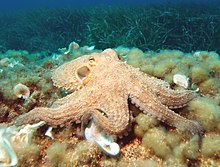
| |
| 真蛸 Octopus vulgaris | |
| 科学分类 | |
| 界: | 动物界 Animalia |
| 门: | 軟體動物門 Mollusca |
| 纲: | 頭足綱 Cephalopoda |
| 亚纲: | 蛸亞綱 Coleoidea |
| 下纲: | 新蛸下纲 Neocoleoidea |
| 总目: | 八腕总目 Octopodiformes |
| 目: | 八腕目 Octopoda Leach, 1818 |
| 模式属 | |
| 章鱼属 Octopus Cuvier, 1791
| |
| 亞目 | |
| 異名 | |
| |
八腕目(学名:Octopoda)又翻譯做章魚目,通称章鱼,亦稱鱆,屬於头足纲,其身體由頭部和八個觸腕拼接而成,既是可食用的經濟物種、也是智商測試中的常客,還是无脊椎动物中少數能反捕食鯊魚、企鵝、海豹、海蛇、海豚等掠食性脊椎動物的。章魚的生物學名稱為“八腕總目”和魷魚、墨魚、烏賊所屬的“十腕總目”相對應,其主要區別為腕足數量的多少。章魚是所有頭足綱、軟體動物、以及無脊椎動物中內智商最高的一目,雖然為純粹的海洋動物,但章魚在陸地上卻還能保持相当的靈活運動能力。
名称
中国南方称章鱼为“八爪魚”,渤海地区称其为“八带鱼”。马来西亚北方称其为“猪母酸”。在臺灣不少人稱其thá-khò(源於日語たこ(蛸) tako),多數人稱為章魚,其他亦有“八带蛸”、“坐蛸”、“死牛”、“石居”、“石吸”、“望潮”等稱呼。
八腕目中的章魚科,是重要的商业性头足类,中国南部沿海的真蛸和北部沿海的短蛸均有一定产量,韓國和日本也把食用章魚當做傳統文化的一部分。蛸的干制品称“八蛸干”或“章鱼干”,除食用外,在中医的理論裡面有补血益气、收敛生肌的作用。
分类与演化
八腕目包含大约300个已知物种,在历史上它被分为两个亚目:无翅亚目和有翅亚目。[1] 但最近的研究认为,有翅亚目只是一类更原始的物种,并不是一个独立的演化支。[2]无翅亚目占了章鱼物种中的大多数,相比有翅亚目,它们缺少两个用于推进游动的鳍,[3] 体内小壳也变为了硬管(Stylet),或者完全消失了。[4]
演化
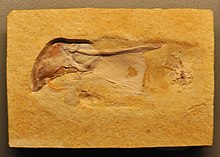
头足类动物是从大约5.3亿年前寒武纪时期的单板纲演化而来的。在大约4.16亿年前的泥盆纪时期,蛸亚纲从鹦鹉螺亚纲分离。在大约2.16亿年前的二叠纪时期,蛸亚纲(包括章鱼和鱿鱼)的外壳逐渐转移到了身体内部,并由此被分类为八腕总目和十腕总目。[5]现代章鱼是从侏罗纪的 Muensterelloidea 超科演化而来的。早期章鱼可能生活在浅海环境,栖息于海底生物界至底层区之间。[5][6][7]章鱼身体的大部分都由软组织构成,所以化石记录比较稀少。作为软体头足类动物,它们缺少亲缘物种(例如鹦鹉螺亚纲和菊石)的坚硬外壳。[8]它们与其它蛸亚纲动物一样有八条肢体,但缺乏被称为触手(触手的学名为tentacle,准确来讲章鱼的触手应当被称为触腕 tentacular arm)的专门用于捕食的肢体,章鱼的肢体更细、更长,仅在其末端附有吸盘。
系统发生学
以下是根据桑切斯等人于2018年基于线粒体与核DNA的分子系统发生学制作的章鱼演化分支图。[9] 其中麝香蛸属的位置来自于伊瓦涅斯等人在2020年发表的一篇文章。[10]年代信息来自于克律格等人在2011年,[11]以及福克斯等人在2019年的文章。[12]
| 头足纲 |
| ||||||||||||||||||
| 5.30 亿年 |
根据对章鱼的遗传分析表明,有翅亚目和船蛸总科不是合理的分类,其中所包含的物种已被重新归类到分支图各处,这些名称在下面的分支图上以引号和斜体显示。
| 八腕目 |
| ||||||||||||||||||||||||||||||||||||||||||||||||||||||||||||||||||||||||||||||||||||||||||
特征

章魚的身體呈現鵝蛋形或圆形,肌肉强健,外套腔开口窄,体表一般不具水孔。
章魚具有3個心臟,血液循環模式為閉鎖式循環;八條腕,每條腕有240個吸盤;雄章魚有一條專門用來交配的腕,稱為化茎腕;章魚的口部具有形似鸚鵡喙的吻部,用以肢解食物,內部具有齒舌,用來刮取微小的食物顆粒。
腕吸盘1列或2列。雄性左侧或右侧第3腕茎化,腕腹缘具精沟,末端具勺状舌叶;化茎腕不能自断。漏斗外套锁退化。吸盤中會有可能有利牙。具1对退化针状内壳或无内壳。若具齿舌,齿舌侧齿一般单尖。胃和盲肠位于消化腺后部。
体型

北太平洋巨型章鱼(学名:Enteroctopus dofleini)被认为是已知体型最大的章鱼,其成年体重通常大约为15 千克,腕展可以达到 4.3 米。[13]有科学记录的最大标本甚至达到了 71 千克。[14]也有人声称见到过更大体型的北太平洋巨型章鱼,[15]其中甚至有达到 272 千克,腕展 9 米的超巨型章鱼。[16] 另一种七胳膊章鱼(学名:Haliphron atlanticus)有记录的最大体型为 75 千克。[17][18] 已知最小的章鱼是邬氏蛸,它的体长约为 2.5 厘米,体重小于 1 克。
体表特征
章鱼的身体以背腹侧为轴,呈对称分布,它们的头与触手以细长身体的前部为基础,向一侧延展,它们的大脑和嘴位于头部。章鱼有一组极其灵活的触手,它们环绕着章鱼的嘴巴,并在基部通过网状结构相连。[19]章鱼的触手可以根据其位置进行描述,例如L1、R1、L2、R2等,并可以据此分为四对。[20][21]通常,两个后附肢被用于在海床行走,另外六个触手用于搜寻食物。椭圆状中空的外套膜位于章鱼头部的另一侧,其中包含了大多数重要的器官。[22] 章鱼的嘴位于触手基部,其中有尖锐、坚硬的牙齿。
章鱼的皮肤由很薄的外表皮以及粘膜和感觉神经元组成,结缔组织真皮主要由胶原蛋白和各种变色细胞组成。[23]由于章鱼的大部分身体都由软组织构成,这使它能够十分方便的伸缩和扭曲身体,并借此穿过微小的缝隙。即使是较大型的章鱼也可以轻松穿过直径约为 2.5 厘米的开口。[24]由于缺少骨骼支撑,章鱼的触手充当了肌肉液压调节器的功能,围绕着神经中轴,其中包含有纵向、横向和环向的肌肉。于是,这些触手可以完成伸展或收缩,向左或向右侧移动,并能够在任何位置保持弯曲或僵直。[25][26]

章鱼触手内侧布满了圆形的吸盘,它可以借助这些吸盘固定自己的位置,或用来抓取物品。吸盘外观类似圆形小碗,它由两个主要部分组成,外围较浅的凹陷被称为外层漏斗(infundibulum),吸盘中心的空腔被称为腹吸盘(acetabulum),两者都是由覆盖着一层保护性几丁质层的肌肉构成的。当吸盘吸附于物体表面,两个结构之间的空隙被密封,此时外层漏斗为吸盘提供了吸附能力,而处于吸盘中心腹吸盘仍可自由活动,于是凭借肌肉的活动,章鱼可以在吸附、脱离状态之间进行调整。[27][28]章鱼的八支触手均可以对光线作出反应,这允许它在视线受阻的情况下保持行动。[29]
章鱼的眼睛位于头部上侧,在结构上与鱼的眼睛类似,它被包裹在与颅骨融合的软骨囊中。章鱼的眼角膜是半透明的表皮层,瞳孔呈狭缝状,像是在角膜后面虹膜上的一个洞。晶状体悬浮在瞳孔后面,最里面是感光的视网膜细胞,它们覆盖了整个眼睛的内侧。瞳孔的大小可以调整,在明亮条件下,视网膜色素会屏蔽部分光线。[30]
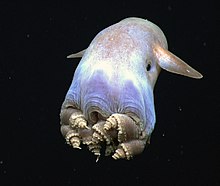
部分章鱼品种有独特的形态。例如有翅亚目有肥硕的躯体,触手基部有网状结构,眼睛上方有两个巨大的由内壳支撑的鳍,它的触手吸盘上有类似纤毛(cirri)的肉状结构,眼睛也更加发达。[31][32]
血液循环
章鱼的循环系统是闭合的,血液在其血管中流动。章鱼有三个心脏,其中一个主心脏负责驱动血液在身体各处的流动,另外两个心脏被称为“鳃心”,它们负责将血液泵进入两个鳃中。当章鱼游动时,它的主心脏并不工作,所以它会很快进入疲惫状态,并更偏向于在海底爬行。[20][24] 章鱼的血液采用含铜的血蓝蛋白储存氧气,故而它们的血液十分粘稠,需要非常大的驱动力才将它们运往身体各处。章鱼的血压可达到 75 毫米汞柱(10 千帕)。[20][24][33]在寒冷环境下,血蓝蛋白传递氧气的效率比血红蛋白更高。血蓝蛋白能够溶解在血浆中,而不是由血细胞携带,这使得它们的血液呈现出偏蓝色。[20][24]
章鱼的主心脏由肌肉心壁、一个心室和分别位于身体两侧的两个心房组成。他们的血管网络由动脉、静脉和毛细血管组成,均内衬有细胞内皮,这与大多数其它无脊椎动物不同。血液从主心脏出发,经由主动脉和毛细血管系统,循环至腔静脉,随后受鳃心驱动进入鳃部,最后流回到主心脏。大部分静脉系统是收缩的,这有助于血液的循环。[34]
呼吸系统

章鱼呼吸时,它通过一个孔洞将水吸入外套腔,通过鳃,最后借助虹吸管将水排出。水的吸入是通过外套腔上放射状肌肉的收缩来实现的,当肌肉促使虹吸管排水时,吸水孔洞就会关闭。[35]广泛的结缔组织网格支撑呼吸肌,使其能够扩大呼吸室的空间。[20]章鱼鳃中的片状结构允许它们从水中分离出大量氧气,在 20 °C 的水中可达 65%。[36]通过鳃的水流与章鱼的运动有关,章鱼可以借助虹吸管的排水来推动身体的移动。[20][37]
章鱼较薄的表皮可以吸收额外的氧气。休息状态的章鱼可通过皮肤吸收大约 41% 所需氧气,当它游动时,这一比例下降到了 33%,因为此时会有更多的水流过它的鳃,游动时皮肤的吸氧量也会增加。当章鱼处于进食后的休息状态时,通过皮肤吸收的氧气可降至总摄氧量的 3%。[38]
消化排泄
章鱼的消化系统始于颊块(buccal mass),它由几丁质的嘴、咽、齿舌和唾液腺组成。[20]齿舌是一个带刺的肌肉舌状器官,其中有多排小齿。[24] 咀嚼后的食物由齿舌和食道侧壁的两个凸起挤入食道。随后顺着食道,食物进入了胃肠道,章鱼大部分胃肠道都位于外套膜的上部。胃肠道包括嗉囊,食物被储存在这个位置。在胃中,食物被磨碎,然后来到盲肠,泥状食物在这里被分离为液体与颗粒物,同时它也负责是营养吸收的主要器官,随后是消化腺,肝细胞在这里分解和吸收液体,将其转变为 "棕色体"。最后肠道将积累的废物转为粪便,通过直肠由虹吸管排出。
当章鱼进行渗透调节时,鳃心的心包会流入液体。章鱼有两个原肾管(相当于脊椎动物的肾脏),它们与鳃心相连。尿液首先在心包腔内形成,主要是一些氨类物质,它在沿着原肾管及其附属组织流动的过程中会被选择性的吸收,成分会发生变化。[39][20]
神经感知
章鱼(以及墨鱼)有着无脊椎动物中最高的大脑-身体比重,[40]甚至也高于许多脊椎动物。[41]章鱼的大脑位于一个软骨腔内,其中仅包含了其复杂神经系统的一部分,剩余的分布在身体各处。[42]其中,有三分之二的神经索位于章鱼的触手,这使它们可以绕过大脑进行复杂的反射活动。[43]与脊椎动物不同,章鱼的运动并不是由大脑通过躯干映射图来统一协调的。[44]
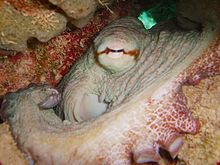
章鱼有着与其它头足类动物一样的,类似相机的眼睛,[45]它可以分辨出光线的偏振。不同章鱼品种的彩色视觉能力似乎各不相同,例如沙蛸(O. aegina )拥有彩色视觉,但普通章鱼(O. vulgaris)却没有。[46]有假设认为,章鱼皮肤上的视蛋白可以独立于眼睛而感知不同波长的光线,这赋予了章鱼变色伪装的能力。[47][48]另一种假设认为,只有一种感光蛋白的头足类动物眼睛可能会借助色差将单色视觉转变为彩色视觉,尽管这会降低图像的质量。这或许能够解释它们类似字母 U、字母 W 或哑铃状的瞳孔形态,以及在交配时的色彩变化。[49]
在章鱼大脑附着有两个被称为平衡石囊的器官,它们外观为囊状结构,其中含有碳酸钙块(mineralised mass)和敏感的纤毛(sensitive hairs)。平衡石囊能够帮助章鱼感知身体的方向。它可以检测章鱼所处位置的重力与角加速度信息。自主神经系统的反馈使章鱼的瞳孔始终处于水平状态。[50]章鱼也可以利用平衡石囊来听侦听声音,它能够分辨出 400-1000 Hz 的声音,最佳听力为 600 Hz。[51]
章鱼有极佳的触觉灵敏度。它们的触手吸盘上带有化学感受器,所以它们可以“品尝”到它们所触摸的物体。感受器可以防止章鱼触手附着在自己身上。[52]章鱼的自我知觉似乎很差,它们需要通过视觉来确定自己肢体的运动状态。[53][54]
墨囊
章鱼的墨囊位于其消化腺下方。墨囊上附有一个腺体,用于分泌墨汁,墨囊储存这些墨汁。墨囊的位置靠近虹吸管,所以排出墨水的动作可以推动章鱼身体迅速移动。墨水从墨囊到虹吸管的途中会混入一些粘液,于是喷出的墨水会在附近产生一片浓厚的黑色浑浊,帮助章鱼从被捕食的险境逃脱。[22] 墨水的主要色素成分是黑色素,[55]有翅亚目通常没有墨囊。[56]
章魚墨汁是粘稠的混懸液,每毫升中含200mg球形顆粒,有些章魚可連續六次往外噴射,儲積“墨汁”需要半個多小時的時間[57]。墨汁的化学成分为黑色素(吲哚醌)和蛋白多糖复合体[58],還有麻痹敵人的毒素,對人類無害可食用,甚至可以作為寫毛筆字用的墨汁。
分布

章鱼广泛分布于世界各大洋的热带及温带海域,不同的章鱼品种适应不同的海洋环境。大多数青少年期的章鱼生活在较浅的潮池。蓝章生活在珊瑚礁生态系统;船蛸漂浮于远洋带;刺断腕蛸生活在靠近海岸的海草环境中。有些章鱼适应了寒冷、黑暗的深海环境,深海多足蛸被发现于海底 1000 米处,火神蛸被发现生活在海底 2000 米处的热泉喷口。[59]有翅亚目通常生活于深海栖息地。[60]尽管研究者发现了一些生活于半深海带和深海带的章鱼,但至今只有一只生活在超深渊带的章鱼被记录在案,这只章鱼属于烟灰蛸属,被发现于 6,957 米下的海底。[61]目前尚未发现生活在淡水环境中的章鱼品种。[62]
章魚为温带性软体动物,适应水温不能低于7℃,海水比重1.021最为适宜,低盐度的环境会死亡。大部分的章魚都生活在海底的洞穴內,甚至在洞穴內等待獵物出現。
習性
章魚都有變色能力,這種變色能力來自章魚體內的色素細胞,當遇到危險及靜止時,有偽裝的作用,藉以逃避敵人及伺機獵食[63][64]。章魚具有發達的大腦。將食物放在一個有蓋的玻璃瓶子內,實驗人員示範打開瓶蓋,再放入章魚的魚缸,章魚會學習並嘗試打開瓶蓋進食。
章魚是肉食性的,食物包括螃蟹、魚類、貝類、海星,大型的章魚甚至捕食龍蝦、大魚及中小型的鯊魚[65]。章魚的天敵不多,“韌魚”是少數能壓倒性制伏章魚的海洋天敵,牠們能將章魚的觸手逐一咬斷。當章魚遇到天敵時,會噴出墨汁逃走,或者以變色偽裝。章魚的觸手如被折斷,不久後可以重新長回。另外,章魚有喜歡鑽進任何的洞穴內的習性,因此一些漁民(特別是日本的漁民)會以此特製出沉在海底的陶製蛸壺,章魚進入蛸壺後便無法逃出來。
在非交配时期,大多数章鱼都独自活动,[66]但也有少数章鱼偏好集体活动,它们会时常聚集在一起,频繁交流,发送信号,保护配偶,或是将某些成员逐出社群。章鱼聚集的原因可能是由于当地食物充足,再加上可选的定居点有限。[67] 其中,太平洋巨型条纹章鱼(LPSO, Larger Pacific Striped Octopus)被认为是最具社会性的章鱼,曾有记录到多达40位成员的 LPSO 社群。[68][69] 章鱼倾向选择坚硬的掩藏物作为栖息处,例如岩石的缝隙,有些章鱼品种也会选择在沙子或淤泥中挖洞作为巢穴。章鱼没有领地意识,但它们仍偏向于在栖息处附近活动,它们有时会到远处寻找食物。章鱼可以借助导航能力回到巢穴,而不必依照原路返回。[70]章鱼不是迁徙性动物。[24]
章鱼会把捕获的猎物带回巢穴。有时章鱼捕获的猎物超出了自己的食物需求,它会将这些多余的尸体与食物残渣丢在巢穴周围。有时,鱼、螃蟹、软体动物和棘皮动物会聚集在章鱼巢穴周围,与它一同分享这些食物,这些小动物有些是食腐者,有些则是章鱼捕食过程中的幸存者。[71]在十分罕见的情况下,章鱼会与其它物种相互合作,会将其它鱼类视为自己的搭档。它会通过用触手拍打的方式来调整狩猎目标的群体组成,以及引导合作搭档的行为。[72]
捕食
几乎所有种类的章鱼都是肉食者。栖息于海底的章鱼主要捕食甲壳动物和多毛纲,并且也捕食其它一些软体动物,例如海螺和蛤蜊。生活在开放海域的章鱼主要捕食对虾、鱼类和其它头足类。[73] 太平洋巨型章鱼的食谱包括双壳纲软体动物,例如鸟尾蛤、蛤蜊、扇贝,以及一些甲壳类动物,例如螃蟹和蜘蛛蟹。章鱼一般不会捕食玉螺,因为它们太大了,章鱼也不会捕食帽贝、岩扇贝、多板纲和鲍鱼,因为它们十分紧密的依附在岩石上,难以采集。[71]
底栖(生活在海底)章鱼通常在岩石间活动,并且可以穿过岩石的缝隙。章鱼可以借助喷射冲向猎物,并使用触手上的吸盘固定猎物,将其拉到嘴边。小型猎物可以被触手基部的网状结构完全包裹。针对螃蟹等甲壳类动物,章鱼会向它们注射一种麻痹性的唾液,然后凭借尖利的喙将其肢解。[73][20]当捕食带壳的软体动物时,章鱼会尝试将它们的外壳掰开,或是在壳上钻一个洞,向里面注入神经毒素。过去人们曾以为章鱼是使用齿舌在贝壳上钻洞的,但现在已经证明,这个过程用到了章鱼唾腺凸起处的微型牙齿,并且它们的唾液中还会分泌出一种可以分解碳酸钙的酶。普通章鱼大约需要花费三个小时才能在甲壳上钻出一个直径 0.6 毫米的洞。一旦外壳被穿透,甲壳类猎物几乎瞬间死亡,随后其肌肉就会松弛,章鱼能够轻易地移除其中的软组织。针对螃蟹的捕食也是同样的方式:章鱼会尝试穿透硬壳螃蟹的外壳,而软壳的螃蟹则直接被撕碎。[74]
部分章鱼品种也有其它捕食方式。例如烟灰蛸属的齿舌已退化甚至消失,所以它们偏向于将猎物整个吞下。[31] 在居住于深海的十字蛸属中,大多数用于控制触手吸盘的肌肉已经被发光器所取代,它们借助光线引诱猎物到嘴边,而这也使得它们成为了少数具备发光能力的章鱼之一。[75]
智力
章魚的智力多寡長久以來一直為科學家所爭論[76][77][78],迷宮等相關解謎實驗顯示章魚具有短期記憶和長期記憶[來源請求],有假說認為章魚幾乎所有的行為都是由學習得來的,而不是靠天生的本能行為。因為章魚無法從親代那邊學習到任何行為,幼年的章魚間也幾乎無任何交流。
章魚具有相當複雜的神經系統,但是腦部只占一部份,三分之二都位於其腕足,這讓章魚的腕足具有許多複雜的自發性動作。章魚複雜的反射動作顯示章魚至少有三種層次的神經控制系統。某些章魚物種,例如擬態章魚,會去模仿其他海中生物的移動方式。
在實驗室中,章魚可以被訓練,使其能夠快速地分辨不同的形狀的物體[79]。章魚也被認為可能具有觀察學習的能力,此外也被觀察到似乎具有遊戲的行為,章魚甚至能夠登上漁船,偷取上面的螃蟹。章魚是唯一被認為具有使用工具能力的無脊椎動物[來源請求],目前發現有四隻紋理章魚身上攜帶著椰子殼,並利用椰子殼當做棲身之所[80][81][82]。
章鱼料理
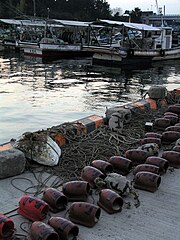
参见
|
参考文献
- ^ Corporation, Marshall Cavendish. Encyclopedia of the Aquatic World. Marshall Cavendish. 2004. ISBN 978-0-7614-7424-1 (英语).
- ^ Sanchez, Gustavo; Setiamarga, Davin H. E.; Tuanapaya, Surangkana; Tongtherm, Kittichai; Winkelmann, Inger E.; Schmidbaur, Hannah; Umino, Tetsuya; Albertin, Caroline; Allcock, Louise. Genus-level phylogeny of cephalopods using molecular markers: current status and problematic areas. PeerJ. 2018-02-12, 6: e4331. ISSN 2167-8359. PMC 5813590
 . PMID 29456885. doi:10.7717/peerj.4331 (英语).
. PMID 29456885. doi:10.7717/peerj.4331 (英语).
- ^ Marshall Cavendish Corporation. Encyclopedia of the aquatic world.. New York: Marshall Cavendish. 2004. ISBN 0-7614-7418-8. OCLC 51445929.
- ^ Fuchs, D.; Ifrim, C.; Stinnesbeck, W. (2008). "A new Palaeoctopus (Cephalopoda: Coleoidea) from the Late Cretaceous of Vallecillo, north-eastern Mexico, and implications for the evolution of Octopoda". Palaeontology. 51 (5): 1129–1139. doi:10.1111/j.1475-4983.2008.00797.x.
- ^ 5.0 5.1 Kröger, Björn; Vinther, Jakob; Fuchs, Dirk. Cephalopod origin and evolution: A congruent picture emerging from fossils, development and molecules. BioEssays. 2011-06-17, 33 (8): 602–613. ISSN 0265-9247. doi:10.1002/bies.201100001.
- ^ Fuchs, Dirk; Schweigert, Günter. First Middle–Late Jurassic gladius vestiges provide new evidence on the detailed origin of incirrate and cirrate octopuses (Coleoidea). PalZ. 2018-06-01, 92 (2): 203–217. ISSN 1867-6812. doi:10.1007/s12542-017-0399-8 (英语).
- ^ Fuchs, Dirk; Iba, Yasuhiro; Heyng, Alexander; Iijima, Masaya; Klug, Christian; Larson, Neal L.; Schweigert, Günter. The Muensterelloidea: phylogeny and character evolution of Mesozoic stem octopods. Papers in Palaeontology. 2019-06-28, 6 (1): 31–92. ISSN 2056-2802. doi:10.1002/spp2.1254.
- ^ A Broad Brush History of the Cephalopoda - The Cephalopod Page. www.thecephalopodpage.org. [2022-03-28].
- ^ Sanchez, Gustavo; Setiamarga, Davin H. E.; Tuanapaya, Surangkana; Tongtherm, Kittichai; Winkelmann, Inger E.; Schmidbaur, Hannah; Umino, Tetsuya; Albertin, Caroline; Allcock, Louise. Genus-level phylogeny of cephalopods using molecular markers: current status and problematic areas. PeerJ. 2018-02-12, 6: e4331. ISSN 2167-8359. PMC 5813590
 . PMID 29456885. doi:10.7717/peerj.4331 (英语).
. PMID 29456885. doi:10.7717/peerj.4331 (英语).
- ^ Ibáñez, Christian M.; Fenwick, Mark; Ritchie, Peter A.; Carrasco, Sergio A.; Pardo-Gandarillas, M. Cecilia. Systematics and Phylogenetic Relationships of New Zealand Benthic Octopuses (Cephalopoda: Octopodoidea). Frontiers in Marine Science. 2020, 7. ISSN 2296-7745. doi:10.3389/fmars.2020.00182.
- ^ Kröger, Björn; Vinther, Jakob; Fuchs, Dirk. Cephalopod origin and evolution: A congruent picture emerging from fossils, development and molecules. BioEssays. 2011-06-17, 33 (8): 602–613. ISSN 0265-9247. doi:10.1002/bies.201100001.
- ^ Fuchs, Dirk; Iba, Yasuhiro; Heyng, Alexander; Iijima, Masaya; Klug, Christian; Larson, Neal L.; Schweigert, Günter. The Muensterelloidea: phylogeny and character evolution of Mesozoic stem octopods. Papers in Palaeontology. 2019-06-28, 6 (1): 31–92. ISSN 2056-2802. doi:10.1002/spp2.1254.
- ^ Giant Pacific Octopus - National Zoo| FONZ. web.archive.org. 2014-02-23 [2022-03-24].
- ^ Cosgrove, J.A. 1987. Aspects of the Natural History of Octopus dofleini, the Giant Pacific Octopus. MSc Thesis. Department of Biology, University of Victoria (Canada), 101 pp.
- ^ Norman, M. 2000. Cephalopods: A World Guide. ConchBooks, Hackenheim. p. 214.
- ^ High, William L. (1976). "The giant Pacific octopus" (PDF). Marine Fisheries Review. 38 (9): 17–22.
- ^ O'Shea, Steve. The giant octopus Haliphron atlanticus (Mollusca: Octopoda) in New Zealand waters. New Zealand Journal of Zoology. 2004-01-01, 31 (1): 7–13. ISSN 0301-4223. doi:10.1080/03014223.2004.9518353.
- ^ O'Shea, S. (2002). "Haliphron atlanticus – a giant gelatinous octopus" (PDF). Biodiversity Update. 5: 1.
- ^ Barnes, Robert D.; Fox, Richard S. Invertebrate zoology : a functional evolutionary approach Seventh edition. Delhi, India. 2004. ISBN 978-81-315-0104-7. OCLC 970002268.
- ^ 20.0 20.1 20.2 20.3 20.4 20.5 20.6 20.7 20.8 Wells, M. J. Octopus : Physiology and Behaviour of an Advanced Invertebrate. Dordrecht. 1978. ISBN 94-017-2468-7. OCLC 1058419500.
- ^ Barnes, Robert D.; Fox, Richard S. Invertebrate zoology : a functional evolutionary approach Seventh edition. Delhi, India. 2004. ISBN 978-81-315-0104-7. OCLC 970002268.
- ^ 22.0 22.1 Anderson, Roland C.; Wood, James B. Octopus : the ocean's intelligent invertebrate. Portland, Or.: Timber Press. 2010. ISBN 978-1-60469-067-5. OCLC 436623449.
- ^ Barnes, Robert D.; Fox, Richard S. Invertebrate zoology : a functional evolutionary approach Seventh edition. Delhi, India. 2004. ISBN 978-81-315-0104-7. OCLC 970002268.
- ^ 24.0 24.1 24.2 24.3 24.4 24.5 Courage, Katherine Harmon. Octopus! : the most mysterious creature in the sea. New York, New York. 2013. ISBN 978-0-698-13767-7. OCLC 861695955.
- ^ OCTOPUSES & RELATIVES: LOCOMOTION: CRAWLING. web.archive.org. 2013-05-22 [2022-03-25].
- ^ Zelman, Ido; Titon, Myriam; Yekutieli, Yoram; Hanassy, Shlomi; Hochner, Binyamin; Flash, Tamar. Kinematic decomposition and classification of octopus arm movements. Frontiers in Computational Neuroscience. 2013, 7. ISSN 1662-5188. PMC 3662989
 . PMID 23745113. doi:10.3389/fncom.2013.00060.
. PMID 23745113. doi:10.3389/fncom.2013.00060.
- ^ Tramacere, Francesca; Beccai, Lucia; Kuba, Michael; Gozzi, Alessandro; Bifone, Angelo; Mazzolai, Barbara. The Morphology and Adhesion Mechanism of Octopus vulgaris Suckers. PLOS ONE. 2013-06-04, 8 (6): e65074. ISSN 1932-6203. PMC 3672162
 . PMID 23750233. doi:10.1371/journal.pone.0065074 (英语).
. PMID 23750233. doi:10.1371/journal.pone.0065074 (英语).
- ^ Kier, William M.; Smith, Andrew M. The Structure and Adhesive Mechanism of Octopus Suckers1. Integrative and Comparative Biology. 2002-12-01, 42 (6): 1146–1153. ISSN 1540-7063. doi:10.1093/icb/42.6.1146.
- ^ Katz, Itamar; Shomrat, Tal; Nesher, Nir. Feel the light: sight-independent negative phototactic response in octopus arms. Journal of Experimental Biology. 2021-03-05, 224 (5): jeb237529. ISSN 0022-0949. doi:10.1242/jeb.237529.
- ^ Barnes, Robert D.; Fox, Richard S. Invertebrate zoology : a functional evolutionary approach Seventh edition. Delhi, India. 2004. ISBN 978-81-315-0104-7. OCLC 970002268.
- ^ 31.0 31.1 Finned Deep-sea Octopuses ~ MarineBio Conservation Society. 2017-05-18 [2022-03-25] (美国英语).
- ^ Marshall Cavendish Corporation. Encyclopedia of the aquatic world.. New York: Marshall Cavendish. 2004. ISBN 0-7614-7418-8. OCLC 51445929.
- ^ Schmidt-Nielsen, Knut. Animal physiology : adaptation and environment Fifth edition. Cambridge. 1997. ISBN 0-521-57098-0. OCLC 35744403.
- ^ Barnes, Robert D.; Fox, Richard S. Invertebrate zoology : a functional evolutionary approach Seventh edition. Delhi, India. 2004. ISBN 978-81-315-0104-7. OCLC 970002268.
- ^ OCTOPUSES & RELATIVES: LOCOMOTION: JET PROPULSION. web.archive.org. 2017-04-28 [2022-03-25].
- ^ Wells, M; Wells, J. The control of ventilatory and cardiac responses to changes in ambient oxygen tension and oxygen demand in octopus. Journal of Experimental Biology. 1995-01-01, 198 (8): 1717–1727. ISSN 0022-0949. doi:10.1242/jeb.198.8.1717.
- ^ Schmidt-Nielsen, Knut. Animal physiology : adaptation and environment Fifth edition. Cambridge. 1997. ISBN 0-521-57098-0. OCLC 35744403.
- ^ Wells, J. Cutaneous respiration in Octopus vulgaris. Journal of Experimental Biology. 1996-11-01, 199 (11): 2477–2483. ISSN 0022-0949. doi:10.1242/jeb.199.11.2477.
- ^ Barnes, Robert D.; Fox, Richard S. Invertebrate zoology : a functional evolutionary approach Seventh edition. Delhi, India. 2004. ISBN 978-81-315-0104-7. OCLC 970002268.
- ^ Albertin, Caroline B.; Simakov, Oleg; Mitros, Therese; Wang, Z. Yan; Pungor, Judit R.; Edsinger-Gonzales, Eric; Brenner, Sydney; Ragsdale, Clifton W.; Rokhsar, Daniel S. The octopus genome and the evolution of cephalopod neural and morphological novelties. Nature. 2015-08, 524 (7564): 220–224. ISSN 1476-4687. PMC 4795812
 . PMID 26268193. doi:10.1038/nature14668 (英语).
. PMID 26268193. doi:10.1038/nature14668 (英语).
- ^ Pilleri, Georg. Investigations on Cetacea. Hirnanatomisches Institut der Universität. 1984 (英语).
- ^ Hochner, Binyamin. An Embodied View of Octopus Neurobiology. Current Biology. 2012-10-23, 22 (20): R887–R892. ISSN 0960-9822. PMID 23098601. doi:10.1016/j.cub.2012.09.001 (英语).
- ^ Yekutieli, Yoram; Sagiv-Zohar, Roni; Aharonov, Ranit; Engel, Yaakov; Hochner, Binyamin; Flash, Tamar. Dynamic Model of the Octopus Arm. I. Biomechanics of the Octopus Reaching Movement. Journal of Neurophysiology. 2005-08-01, 94 (2): 1443–1458. ISSN 0022-3077. doi:10.1152/jn.00684.2004.
- ^ Zullo, Letizia; Sumbre, German; Agnisola, Claudio; Flash, Tamar; Hochner, Binyamin. Nonsomatotopic Organization of the Higher Motor Centers in Octopus. Current Biology. 2009-10-13, 19 (19): 1632–1636. ISSN 0960-9822. PMID 19765993. doi:10.1016/j.cub.2009.07.067 (英语).
- ^ Albertin, Caroline B.; Simakov, Oleg; Mitros, Therese; Wang, Z. Yan; Pungor, Judit R.; Edsinger-Gonzales, Eric; Brenner, Sydney; Ragsdale, Clifton W.; Rokhsar, Daniel S. The octopus genome and the evolution of cephalopod neural and morphological novelties. Nature. 2015-08, 524 (7564): 220–224. ISSN 1476-4687. PMC 4795812
 . PMID 26268193. doi:10.1038/nature14668 (英语).
. PMID 26268193. doi:10.1038/nature14668 (英语).
- ^ 軍蔵, 川村; 一夫, 信時; 和彦, 安樂; 淑人, 田中; 一, 岡本. 色弁別学習を用いたスナダコとマダコの色覚比較. 日本水産学会誌. 2001, 67 (1): 35–39. doi:10.2331/suisan.67.35.
- ^ Kingston, Alexandra C. N.; Kuzirian, Alan M.; Hanlon, Roger T.; Cronin, Thomas W. Visual phototransduction components in cephalopod chromatophores suggest dermal photoreception. Journal of Experimental Biology. 2015-05-15, 218 (10): 1596–1602. ISSN 0022-0949. doi:10.1242/jeb.117945.
- ^ Ramirez, M. Desmond; Oakley, Todd H. Eye-independent, light-activated chromatophore expansion (LACE) and expression of phototransduction genes in the skin of Octopus bimaculoides. Journal of Experimental Biology. 2015-05-15, 218 (10): 1513–1520. ISSN 0022-0949. PMC 4448664
 . PMID 25994633. doi:10.1242/jeb.110908.
. PMID 25994633. doi:10.1242/jeb.110908.
- ^ Hu, Marian Y.; Yan, Hong Young; Chung, Wen-Sung; Shiao, Jen-Chieh; Hwang, Pung-Pung. Acoustically evoked potentials in two cephalopods inferred using the auditory brainstem response (ABR) approach. Comparative Biochemistry and Physiology Part A: Molecular & Integrative Physiology. 2009-07-01, 153 (3): 278–283. ISSN 1095-6433. doi:10.1016/j.cbpa.2009.02.040 (英语).
- ^ Barnes, Robert D.; Fox, Richard S. Invertebrate zoology : a functional evolutionary approach Seventh edition. Delhi, India. 2004. ISBN 978-81-315-0104-7. OCLC 970002268.
- ^ Hu, Marian Y.; Yan, Hong Young; Chung, Wen-Sung; Shiao, Jen-Chieh; Hwang, Pung-Pung. Acoustically evoked potentials in two cephalopods inferred using the auditory brainstem response (ABR) approach. Comparative Biochemistry and Physiology Part A: Molecular & Integrative Physiology. 2009-07-01, 153 (3): 278–283. ISSN 1095-6433. doi:10.1016/j.cbpa.2009.02.040 (英语).
- ^ Nesher, Nir; Levy, Guy; Grasso, Frank W.; Hochner, Binyamin. Self-Recognition Mechanism between Skin and Suckers Prevents Octopus Arms from Interfering with Each Other. Current Biology. 2014-06-02, 24 (11): 1271–1275. ISSN 0960-9822. PMID 24835454. doi:10.1016/j.cub.2014.04.024 (英语).
- ^ Gutnick, Tamar; Byrne, Ruth A.; Hochner, Binyamin; Kuba, Michael. Octopus vulgaris Uses Visual Information to Determine the Location of Its Arm. Current Biology. 2011-03-22, 21 (6): 460–462. ISSN 0960-9822. PMID 21396818. doi:10.1016/j.cub.2011.01.052 (英语).
- ^ Kennedy, E. B. Lane; Buresch, Kendra C.; Boinapally, Preethi; Hanlon, Roger T. Octopus arms exhibit exceptional flexibility. Scientific Reports. 2020-11-30, 10 (1): 20872. ISSN 2045-2322. PMC 7704652
 . PMID 33257824. doi:10.1038/s41598-020-77873-7 (英语).
. PMID 33257824. doi:10.1038/s41598-020-77873-7 (英语).
- ^ Derby, Charles D. Cephalopod Ink: Production, Chemistry, Functions and Applications. Marine Drugs. 2014-05, 12 (5): 2700–2730. ISSN 1660-3397. PMC 4052311
 . PMID 24824020. doi:10.3390/md12052700 (英语).
. PMID 24824020. doi:10.3390/md12052700 (英语).
- ^ Finned Deep-sea Octopuses ~ MarineBio Conservation Society. 2017-05-18 [2022-03-28] (美国英语).
- ^ Mather, Anderson & Wood (2010),第107頁.
- ^ Derby, C. D. Cephalopod Ink: Production, Chemistry, Functions and Applications. Marine Drugs. 2014, 12 (5): 2700–2730. doi:10.3390/md12052700.
- ^ Anderson, Roland C.; Wood, James B. Octopus : the ocean's intelligent invertebrate. Portland, Or.: Timber Press. 2010. ISBN 978-1-60469-067-5. OCLC 436623449.
- ^ Corporation, Marshall Cavendish. Encyclopedia of the Aquatic World. Marshall Cavendish. 2004. ISBN 978-0-7614-7424-1 (英语).
- ^ Jamieson, Alan J.; Vecchione, Michael. First in situ observation of Cephalopoda at hadal depths (Octopoda: Opisthoteuthidae: Grimpoteuthis sp.). Marine Biology. 2020-05-26, 167 (6): 82. ISSN 1432-1793. doi:10.1007/s00227-020-03701-1 (英语).
- ^ Are there any freshwater cephalopods?. www.abc.net.au. 2013-01-16 [2022-03-24] (澳大利亚英语).
- ^ Ruppert, Edward E.; Fox, Richard S.; Barnes, Robert D. Invertebrate Zoology. Cengage Learning. 2008: 363–364. ISBN 978-81-315-0104-7.
- ^ Semmens. Understanding octopus growth: patterns, variability and physiology. Marine and Freshwater Research. 2004, 55: 367. doi:10.1071/MF03155.
- ^ (英文)章魚吃鯊魚. National Geographic.
- ^ What’s Odd About That Octopus? It’s Mating Beak to Beak.. Magazine. 2016-04-01 [2022-03-29] (英语).
- ^ Scheel, David; Chancellor, Stephanie; Hing, Martin; Lawrence, Matthew; Linquist, Stefan; Godfrey-Smith, Peter. A second site occupied by Octopus tetricus at high densities, with notes on their ecology and behavior. Marine and Freshwater Behaviour and Physiology. 2017-07-04, 50 (4): 285–291. ISSN 1023-6244. doi:10.1080/10236244.2017.1369851.
- ^ Rodaniche, Arcadio F. (1991). "Notes on the behavior of the Larger Pacific Striped Octopus, an undescribed species of the genus Octopus". Bulletin of Marine Science. 49: 667.
- ^ Caldwell, Roy L.; Ross, Richard; Rodaniche, Arcadio; Huffard, Christine L. Behavior and Body Patterns of the Larger Pacific Striped Octopus. PLOS ONE. 2015-08-12, 10 (8): e0134152. ISSN 1932-6203. PMC 4534201
 . PMID 26266543. doi:10.1371/journal.pone.0134152 (英语).
. PMID 26266543. doi:10.1371/journal.pone.0134152 (英语).
- ^ Mather, Jennifer A. Navigation by spatial memory and use of visual landmarks in octopuses. Journal of Comparative Physiology A. 1991-04-01, 168 (4): 491–497. ISSN 1432-1351. doi:10.1007/BF00199609 (英语).
- ^ 71.0 71.1 Carefoot, Thomas. "Octopuses and Relatives: Feeding, diets and growth". A Snail's Odyssey. Archived from the original on 8 May 2017. Retrieved 13 April 2017.
- ^ Sampaio, Eduardo; Seco, Martim Costa; Rosa, Rui; Gingins, Simon. Octopuses punch fishes during collaborative interspecific hunting events. Ecology. 2021-02-02, 102 (3). ISSN 0012-9658. doi:10.1002/ecy.3266.
- ^ 73.0 73.1 Taonga, New Zealand Ministry for Culture and Heritage Te Manatu. Feeding and predation. teara.govt.nz. [2022-03-29] (英语).
- ^ Carefoot, Thomas. "Octopuses and Relatives: Prey handling and drilling". A Snail's Odyssey. Archived from the original on 6 June 2017. Retrieved 21 April 2017.
- ^ Johnsen, S.; Balser, E. J.; Fisher, E. C.; Widder, E. A. Bioluminescence in the Deep-Sea Cirrate Octopod Stauroteuthis syrtensis Verrill (Mollusca: Cephalopoda). The Biological Bulletin. 1999-08-01, 197 (1): 26–39. ISSN 0006-3185. doi:10.2307/1542994.
- ^ Stewart, Doug. Armed but not dangerous: Is the octopus really the invertebrate intellect of the sea. National Wildlife. 1997, 35 (2) [2018-06-06]. (原始内容存档于2014-05-19).
- ^ Giant Octopus – Mighty but Secretive Denizen of the Deep. Web.archive.org. 2 January 2008 [4 February 2014]. (原始内容存档于2012-08-25).
- ^ Zimmer, Carl. How Smart is the Octopus?. Slate.com. 23 June 2008 [2018-06-06]. (原始内容存档于2018-07-26).
- ^ Octopus intelligence: Jar opening. BBC News. 25 February 2003 [4 February 2014]. (原始内容存档于2020-11-28).
- ^ Finn, J. K.; Tregenza, T.; Norman, M. D. Defensive tool use in a coconut-carrying octopus. Current Biology. 2009, 19 (23): R1069–70. PMID 20064403. doi:10.1016/j.cub.2009.10.052.
- ^ Morelle, Rebecca. Octopus snatches coconut and runs. BBC News. 14 December 2009 [20 May 2010]. (原始内容存档于2014-05-18).
- ^ Coconut shelter: evidence of tool use by octopuses. EduTube Educational Videos. [4 February 2014]. (原始内容存档于2013-10-24).
延伸阅读
[在维基数据编辑]










